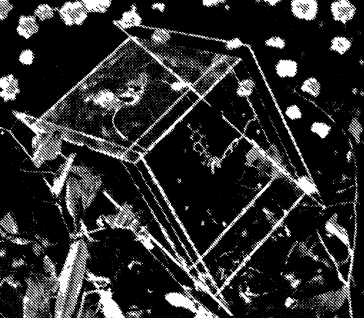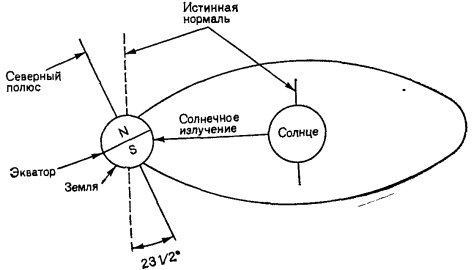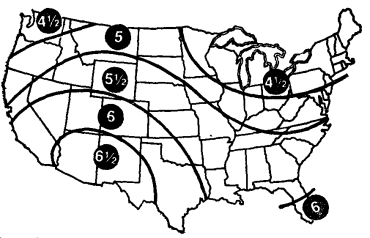
|
|
ENCYCLOPEDIA OF RADIO ELECTRONICS AND ELECTRICAL ENGINEERING Solar radiation dosimeter. Encyclopedia of radio electronics and electrical engineering
Encyclopedia of radio electronics and electrical engineering / Alternative energy sources When creating any structures that use solar energy, it is necessary to know the total amount of sunlight available for photovoltaic conversion. Although the energy of solar radiation at certain moments of time can be large, it is rarely possible to establish from these instantaneous values the nature of solar radiation during the day. To do this, it is necessary to average the value of solar energy over a long period of time.
The amount of potentially useful solar radiation falling on the illuminated surface is determined by a concept called insolation. Solar insolation varies greatly from one point on the earth's surface to another. The deserts of New Mexico receive significantly more sunlight than Chicago or San Francisco. When determining the insolation value of any area, several factors must be taken into account. Duration of solar exposure (in hours) To take into account all the factors that affect the change in the use of solar energy, it is necessary to introduce a unit of measurement that is completely different from those that we have used so far. The most effective is the duration of solar exposure, i.e., the time of useful use of solar energy (in hours). The phrase "beneficial use" will often be mentioned in the future. Measuring the duration of solar exposure is quite simple. In essence, all that needs to be done is to count the number of hours per day during which the sun shines, that is, the number of useful hours for use. Several factors will influence our measurement. Influence of the season Undoubtedly, the most important factor is the angle of incidence of sunlight on the Earth's surface. When the Earth rotates around the Sun, its axis is not perpendicular to the direction of the Sun, but is inclined to it at an angle of about 23. In fact, the rotation axes of 5 of the 9 planets of the Solar System are slightly inclined. Therefore, the sun's rays fall on the Earth not exactly perpendicular to the equator. Instead, the point of perpendicular dip moves north and then south of the equator during the year. This effect is reflected in the change of seasons.
When the North Pole is tilted away from the Sun, as shown in Fig. 1, the Sun illuminates regions of the rotating globe well south of the equator; for those who live in the Northern Hemisphere, the Sun passes through the sky low on the horizon.
As a result, the days become shorter. The shorter the days, the less energy comes from the Sun, and winter sets in. As the Earth rotates around the Sun, the North Pole gradually turns towards the Sun. In spring, the mutual arrangement of the Earth and the Sun is such that solar energy falls directly on the equator. Meanwhile, the Earth continues its movement around the Sun. When it passes half of the orbit, the North Pole turns towards the Sun (Fig. 2). This allows solar radiation to concentrate its energy north of the equator. The days are getting longer and the Earth is able to absorb and store more incoming solar energy. For us, the increase in insolation feels like the onset of summer. The difference between the length of summer and winter days for most of the continental United States of America is 6 hours (Fig. 3).
The earth continues its journey, goes through a full cycle and returns to the starting point. Then the seasonal and solar cycles begin again. Of course, for those living in the Southern Hemisphere, the seasons will be exactly the opposite of ours. When we get cold in winter, they bask in the sun during the long summer days. Local weather conditions The change in the height of the sun's rise above the horizon during the course of the year can be accurately predicted and easily accounted for. On the other hand, local weather patterns also have a marked effect on solar insolation, but are more difficult to predict. Clouds influence the weather the most. Even if they do not completely cover the sun, they can significantly weaken the passage of sunlight. Depending on the type of cloudiness, the intensity of solar radiation can decrease by 20-50%. A particular problem is the variety of shapes and sizes of clouds. Light, cirrus clouds only slightly reduce the amount of sunlight reaching the earth's surface. Therefore, they can be neglected to some extent. On the other hand, dense, cumulus clouds let in very little light. If there are breaks in the cloud cover, the sun will appear and disappear again. Therefore, it is necessary to estimate the amount of sunlight penetrating through the cloud cover. Is it enough for photoelectric conversion? Or is the light too low? In order to accurately take all this into account, it is necessary to determine the lower limit level of light that is still appropriate for photoelectric conversion. The calculation is carried out if the light intensity exceeds this level. Otherwise, the calculation is terminated. Fog, rain or haze also make their corrections. In fact, weather is a one-of-a-kind environmental variable. Areas that are only 50 km apart can have completely different insolation conditions. The nature of the area illuminated by the sun In conclusion, it is necessary to consider the terrain. Suppose there is a large hill blocking the sun until 10 o'clock in the morning. Thus, even if the sun rises at 7 o'clock in the morning, we will not be able to use its energy until it appears over the top of the hill. Essentially 3 hours potentially usable are lost. The setting sun poses another problem for us, since it is likely that the tops of the trees will block its rays at 4 pm. Although this may not interfere with the evening rest on the cool veranda, it will certainly reduce the amount of solar energy used. And while the sunset can be amazing, the rays of the setting sun are nowhere near as energetic as we would like. The combination of several factors narrows the boundaries of the highest productivity of solar radiation in the interval from approximately 10 am to 4 pm. In this case, it is necessary to take into account the change in the angle of incidence of the sun's rays as the sun moves across the sky during the day, if you do not have a device for tracking the movement of the sun. The sun's rays falling on the illuminated surface at a very small angle become unsuitable for use. All of the above factors determine the total useful time of solar energy. Insolation meter At present, it is quite simple to design a solar insolation meter that satisfies the above requirements. If we want to establish the actual length of the time interval during which solar illumination is useful in relation to our photovoltaic converters, it is natural to choose a silicon solar cell as the radiation sensor. This design will require a low-power power supply that generates 1,5 V at 3 mA. It can be made from several small elements connected in series in a manner reminiscent of laying a tiled roof (chapter 1). Then the solar battery should be attached to a quartz mechanical watch, which consumes very little energy. When sunlight hits the photovoltaic converter, the electrical energy released will set the clock in motion. By recording the amount of time per day that the clock was running, you will get the solar exposure per day (in hours). To detect the difference in the intensity of solar radiation, a resistor is connected to the solar battery, which plays the role of loading the solar cells, slightly reducing their voltage. As long as the light intensity does not exceed a certain level, corresponding to the level of useful work of the solar battery, the voltage developed by it is not enough to power the clock and this time is not recorded. Meter design The body of the solar insolation meter is made entirely of acrylic plastic, such as plexiglass. I took a sheet of plexiglass, which is sometimes used to create double window frames and is usually commercially available. From this sheet should be cut two pieces measuring 10x12 cm, one piece measuring 10x10 cm2 and one piece measuring 14x14 cm2. Then cut a piece of 14x14 cm2 diagonally into two triangles. Next, in the center of the 10x10 cm2 plate, drill a hole with a diameter of 9 mm. When drilling a hole in a thermoplastic material such as acrylic, heat must be avoided, otherwise the plastic will melt. Use the same precaution when cutting plastic. The best results can be achieved with low drilling and cutting speeds, but with sufficient pressure. Now you can start assembling. First, it is necessary to fasten the quartz clock with nuts in a hole with a diameter of 9 mm on a plate measuring 10x10 cm2. If desired, you can equip the timer with a dial from a wall clock (it is pressed with connecting nuts). For my model, I simply drilled 12 holes in a circle in the plate to indicate the position of the arrows. Now the parts are glued together as shown in Fig. 4. Although acrylic adhesive is preferred, other types of adhesive can be used. I recommend gluing the rectangular plates to only one triangular plate first and only then attaching the second triangular plate. This will allow you to more accurately combine the parts and avoid smearing the glue. The solar panel is then attached to a sheet of plastic behind the clock. A light solar battery is easily attached to the plastic for the current-carrying conductors attached to the contacts of the element, using glue droplets. It is necessary to avoid getting glue on the surface of solar cells.
It should be noted that the conductors are not insulated and are not marked in any way. Connect the conductor coming from the front (photosensitive) surface of the element to the negative (-) contact of the clock power supply. The other conductor coming from the rear is connected to the positive (+) power input. Finally, a 220 ohm resistor is soldered to the terminals of the solar panel as a load. The design is now ready for measurements. Insolation measurement The device can be used in two ways. You can at least start by setting the clock to an easy-to-remember time (I usually set it to 12 o'clock) and point the sensor to the south. The azimuth angle of the solar array is 45°, which is approximately the correct installation for most areas of the US. Measurements begin early in the morning, at dawn. Now, until sunset, the device will record the number of hours during which the sun provides enough energy to use. This automatically takes into account the influence of passing clouds and periods of incidence of rays at an acute angle to the surface (at which a very small amount of energy falls on the battery). At the end of the day, you can directly read the number of useful hours of sunshine per day. If the hand points to 5, then there were 5 useful hours. Set the clock again and it's ready for the next day. Using another method, you can get the cumulative value of insolation. The readings are simply noted every day without changing the clock and the total number of turns of the hand during the measurement is counted. The result is insolation conditions over a long period of time. You can determine the average value of the duration of solar exposure (in hours) in several different ways: per week, per season, per year. It all depends on what data is needed. Author: Byers T.
Alcohol content of warm beer
07.05.2024 Major risk factor for gambling addiction
07.05.2024 Traffic noise delays the growth of chicks
06.05.2024
▪ Jeans with pockets for smartphone and charger ▪ Artificial photosynthesis system for methane production ▪ Bacteria can survive interplanetary travel
▪ section of the site Power supply. Article selection ▪ article For the construction of track car models. Tips for a modeller ▪ Article Assistant to the head of the enterprise. Job description ▪ article Electric cat. physical experiment
Home page | Library | Articles | Website map | Site Reviews www.diagram.com.ua |






 Arabic
Arabic Bengali
Bengali Chinese
Chinese English
English French
French German
German Hebrew
Hebrew Hindi
Hindi Italian
Italian Japanese
Japanese Korean
Korean Malay
Malay Polish
Polish Portuguese
Portuguese Spanish
Spanish Turkish
Turkish Ukrainian
Ukrainian Vietnamese
Vietnamese





 Leave your comment on this article:
Leave your comment on this article: